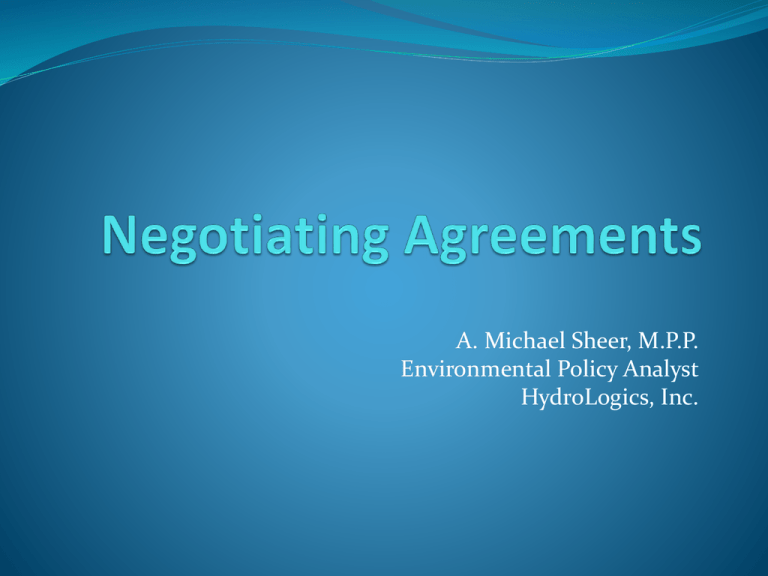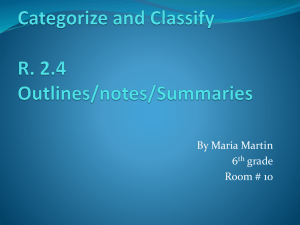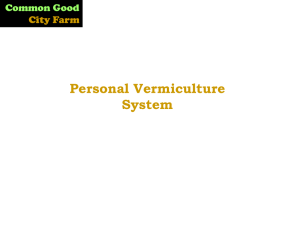Power Point Slides - HydroLogics, Inc.
advertisement

A. Michael Sheer, M.P.P. Environmental Policy Analyst HydroLogics, Inc. Exercise: Scenario Ayawannadawadda River: Typical flow - 500 cfs Exercise: Scenario Ayawannadawadda River: Typical flow - 500 cfs Farm 2 Farm 1 Exercise: Scenario Ayawannadawadda River: Typical flow - 500 cfs Farm 2 $500 ($0) Canal capacity: 500 cfs Farm 2 Split Canal capacity: 500 cfs Split Farm 1 $500, $0 $0, $500 Farm 1 Full Full $500, $0 Exercise: Scenario Note: These farms are more efficient with lower flows, so . . . Farm 2 $300 At 250 cfs Farm 2 Split At 250 cfs Full Split $300, $300 $0, $500 Farm 1 $300 Farm 1 Full $500, $0 Exercise: Scenario Farm 2 Canal Gate Benevolent(ish) Dictator Farm 1 Exercise: Scenario AMike’s Rules: 1. Provide the greatest demand first, anything after gets shorted 2. If there is a tie, and not enough water for both, send only a minimum to each (Just enough to prevent starvation) Farm 2 Split Full Split $300, $300 $0, $500 Farm 1 Full $500, $0 $100, $100 Exercise: Instructions Farm 2 Split Full Split $300, $300 $0, $500 Farm 1 Full $500, $0 $100, $100 Exercise Instructions: 1. Split into groups (4 of 2 people, 2 of 1 person). Match up 2v2 and 1v1. 2. Each group will have 2 minutes to figure out their decision for each round. 3. Once decided, write it on a slip of paper, and bring it to me. When everyone has turned in a decision, I will reveal the actions for the round and we will score it. Exercise: Results Sheet Round 1 2 3 4 5 6 7 8 9 10 11 Action Farm 1 Farm 2 _____ _____ _____ _____ _____ _____ _____ _____ _____ _____ _____ _____ _____ _____ _____ _____ _____ _____ _____ _____ _____ _____ Profit for the Month Farm 1 Farm 2 _____ _____ _____ _____ _____ _____ _____ _____ _____ _____ _____ _____ _____ _____ _____ _____ _____ _____ _____ _____ _____ _____ Total Profit Farm 1 Farm 2 _____ _____ _____ _____ _____ _____ _____ _____ _____ _____ _____ _____ _____ _____ _____ _____ _____ _____ _____ _____ _____ _____ Exercise: Actions & Results Round 1 2 3 4 5 6 7 8 9 10 11 Group 1 Farm 1 Farm 2 _____ _____ _____ _____ _____ _____ _____ _____ _____ _____ _____ _____ _____ _____ _____ _____ _____ _____ _____ _____ _____ _____ Group 2 Farm 1 Farm 2 _____ _____ _____ _____ _____ _____ _____ _____ _____ _____ _____ _____ _____ _____ _____ _____ _____ _____ _____ _____ _____ _____ Group 3 Farm 1 Farm 2 _____ _____ _____ _____ _____ _____ _____ _____ _____ _____ _____ _____ _____ _____ _____ _____ _____ _____ _____ _____ _____ _____ Exercise: Results Breakdown What happened? Why did it happen? Group-by-group. . . How is this similar to real life situations? Consider both scenario and results! How is this different? Consider both scenario and results! NEGOTIATIONS PRIMER How to get what you need, explained in 30 minutes or less 13 Step 1 – Understand Yourself: The Dual Concern Model Know your tendencies so you don’t let them interrupt your process! Make sure your method is best suited to the conflict. Do you typically: 14 Compete - Do you try to “win”? Collaborate - Do you work together without giving up anything? Accommodate - Do you give concessions to get out of the conflict? Avoid - Do you walk out or change the subject? Compromise - Do you find the middle ground for a fast solution? Step 2 – Understand the Conflict: The 9 Elements 9 Elements of Interest-Based Negotiations Context Setting Core Elements Parties Issues Influencing Exit Elements Interests Communications Alternatives Options Relationships Commitment Standards Context setting: I. 1. Parties: Who is necessary to reach agreement and to implement the agreement successfully? 2. Issues - What are the underlying causes for the conflict? What issues need to be discussed or decided? Core Elements II. 3. Interests - What are the parties really after? Interests include tangible and intangible needs. 4. Options - List all ways the situation can be mutually resolved and understand that consent is needed. 5. Standards - for fair process. Look at objective (and/ qualitative) standards that help judge whether an agreement is fair. Influencing III. 6. Communications - What do you need to know from each other? What is the current quality of communication vs. what you need for a working relationship 7. Relationships – What is the current quality of the relationship? How should it be different to help negotiations? How might this change come about? Exit Elements IV. 8. Alternatives - What is your BATNA (Best Alternative to a Negotiated Agreement)? 9. Commitment - What are the set of options that the parties agree to and are they feasible options? 15 Step 3 – How do I get to Yes? (The X Plan) What actions (options) address each favorable interest in the target balance sheet? Do the actions address the significant issues? Do the actions meet the interests of the parties? Be sure the actions also satisfy your interests! Are the actions legitimate - standards of fairness? Are the actions feasible and operational – doable? Reformulate the Question asking for a YES or NO response 16 Step 4 Make it Easy to Say Yes: Circle Chart Analysis Systems thinking to identify the problem: II DIAGNOSIS Why— is the current situation the way it is? are there gaps between the current situation and the preferred state? how do I explain the gaps? GROUP ANALYSIS bundle your explanation into key issues to be addressed III OBJECTIVES State in positive terms what quantifiable long-term objectives you would pursue to address each issue. These objectives should be long-term aspirations and challenging. They should say “what” it is that you want to accomplish, not “how”. [These are refinements of the vision tied to each issue identified in II.] [ Before going to III, ask: Have I identified all significant parties? Do I know their interests? Refined the issues in play? Looked at questions of communication and relationship between parties? Considered alternatives? Considered standards of legitimacy?] I PROBLEM State the Problem: As you see it. As the other parties see it. Describe the current situation in terms of its symptoms. What is happening, not “why.” E.g. We disagree on “X.” Parties aren’t talking to each other. What is your preferred long-term vision 3-5 years from now if you were very successful in addressing it? 17 IV SPECIFIC ACTIONS For each objective list the specific near, mid-range and long term actions that would be necessary for success. These actions should say “how” the objective would be reached. For each action, indicate who would be responsible, resources needed, and timing. Step 4 Make it Easy to Say Yes: Circle Chart Analysis Systems thinking to identify the problem II DIAGNOSIS I PROBLEM Statement Symptoms PREFERRED VISION 18 III OBJECTIVES IV SPECIFIC ACTIONS Step 5 – How to Get Past No 5 strategies: The Goal: Joint Problem Solving Barriers to Cooperation Strategy to Overcome: Hasty Reactions People Sitting Side-by-Side Negative Emotions Facing the Problem Rigid Positions Reaching a Mutually Satisfactory Agreement Strong Dissatisfactions Perceived Power 1. Go to the Balcony - Step back for a big picture view - Let negativity flow past you 2. Step to their side - Active Listening, Acknowledge the person, etc. 3. Reframe the issue - Ask problem solving questions - Reframe tactics (expose tricks) - Negotiate the Rules 4. Build them a Golden Bridge - “Their” idea - Consider all “unmet” needs - Save face - Don’t go for too much too fast - Expand the pie 5. Use power to educate - Don’t make it hard for them to say “no,” make it easy to say yes” 19 Multiparty Negotiations: Process Suggestions The Process is the Result Preliminaries Identify stakeholders Meet with key stakeholders to discuss set-up matters: (Use of facilitator, Meeting sequences, Representation in negotiation, Need for conflict assessment) Negotiations Key stakeholders meet to decide on negotiation rules and procedures Identify other relevant stakeholders, establish an air traffic controller group Agree on task/meeting sequence, and ratification by decision makers Agree on issue defining meeting (9 step, circle chart) Create working groups to deal with substantive issues (prepare drafts , check in with decision-makers) Create agreement: Draft by negotiators, and ratification by decision makers Implementation 20 Assessment of progress (decide on timings) Use of problem solving meetings Set up Renegotiations





